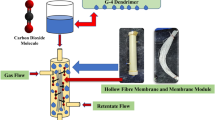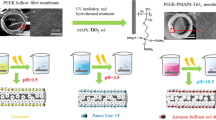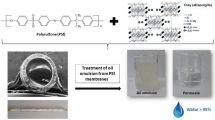Abstract
Industrial wastewater often contains xenobiotics such as heavy metals, dyes and proteins, yet there is a lack of efficient cleaning methods. Therefore, here we fabricated hollow fiber membranes using polyphenylsulfone containing 1, 3 and 5 wt% of cellulose acetate and cellulose acetate phthalate by non-solvent induced phase separation. Membrane morphology was characterized by field emission scanning electron microscopy. The hydrophilicity of the membranes was measured by contact angle, water uptake and porosity measurement. The thermal miscibility of the membrane with additives was assessed by thermogravimetric analysis. Hollow fiber membranes were tested for separation of azo dyes, e.g., reactive orange 16 and reactive black 5, and of proteins: bovine serum albumin, egg albumin and pepsin. Results show increasing rejection of dyes and proteins with the content of cellulose acetate and cellulose acetate phthalate. Water permeability was 41.26 L/m2 h bar for the polyphenylsulfone membrane, 64.47 L/m2 h bar for the polyphenylsulfone/5 wt% cellulose acetate membrane and 72.60 L/m2 h bar for the polyphenylsulfone/5 wt% cellulose acetate phthalate membrane.
Similar content being viewed by others
Explore related subjects
Discover the latest articles, news and stories from top researchers in related subjects.Avoid common mistakes on your manuscript.
Introduction
Nowadays, water bodies get polluted due to urbanization and the continuous development of various industrial activities. The disposal of wastewater from different industries such as textile, printing, pulp and paper industry is a major issue. Moreover, wastewater contains many metal ions, hazardous proteins and various reactive dyes. Intake of harmful dyes/proteins can cause skin irritation, permanent blindness, vomiting, gastritis, vertigo, edema of the face, neck, pharynx, tongue and larynx along with respiratory distress (Varghese et al. 2019; Ibrahim et al. 2017). Based on severe health issues related to hazardous dyes and proteins, it is essential to develop a cost-effective alternative treatment for effectively decontaminate different dye/protein effluents from the aqueous solutions. Many technologies were reported for the removal of dyes/proteins from the aqueous solution. Among these technologies, membrane-based filtration process has been one of the most widely used technologies in recent years. Ultrafiltration membrane process was considered as effective process for membrane filtration and retention (Kumar et al. 2019; Ibrahim et al. 2018).
According to our knowledge, no research work was documented related to polyphenylsulfone/cellulose acetate and polyphenylsulfone/cellulose acetate phthalate hollow fiber membranes for hazardous dye/protein rejection from the aqueous solution. To fulfill the above requisite, it was decided to fabricate the asymmetric hollow fiber membranes. The fabricated membranes were thoroughly characterized by hydrophilic properties and various dyes/proteins retention studies.
Experimental
Materials and methods
Cellulose acetate and cellulose acetate phthalate (molecular weight 50,000 and acetylene content of 39.7 wt%), bovine serum albumin (66.43 kDa), egg albumin (42.69 kDa) and pepsin (35 kDa) were procured from Sigma-Aldrich Company Ltd., India. Polyphenylsulfone with molecular weight of 50,000 g/mol, Radel R-5000 was furnished from Solvay polymer company, Belgium. N-methyl-2-pyrrolidone was furnished from Loba Chemical Pvt. Ltd., India. Reactive black 5 and reactive orange 16 were procured from Sigma-Aldrich, USA.
Preparation of hollow fiber membranes
Asymmetric hollow fiber membranes were fabricated using polyphenylsulfone as polymer along with cellulose acetate and cellulose acetate phthalate as additives by phase inversion, dry–wet spinning process (Kolangare et al. 2019b). The dope solution was prepared by dispersing the calculated amount of additives and polyphenylsulfone in n-methyl-2-pyrrolidone. For preparing the membranes, the dope solution was permitted to flow through the spinneret with the aid of nitrogen gas pressure. Deionized water was used as bore fluid, and membranes were collected in rotating drum. Collected membranes were immersed in distilled water followed by 10% glycerol and water solution to eliminate pore shrinkage and collapse. The detailed parameters are given in Table 1.
Characterization of prepared membranes
The Zeiss, Sigma, field emission scanning electron microscopy was used for analyzing the cross-sectional and surface morphologies of the fabricated membranes. Sputter coating was done using sputter coater (Emitech K-575) on fractured surfaces of membranes before the scanning process. A thermogravimetric analysis of the membranes was carried out using thermogravimetric analyzer (STA 449F3, Netzsch), Germany, with airflow rate of 20 cm3/min, within the temperature range of 40 to 800 °C and heating rate of 10 °C/min. With the help of sessile droplet technique, hydrophilic/hydrophobic behavior of the membranes was evaluated using dynamic FTA-200 contact angle apparatus. Membranes wet weight was recorded by closing both ends of the membranes and immersed in the distilled water about 24 h. Later, the membranes were dried in hot air oven about 8 h at 60 °C and dry weight was recorded. The porosity of the prepared membranes was evaluated with dry–wet weigh method (Kumar et al. 2019). The percentage water uptake and porosity of the membranes were calculated as illustrated in S1, supporting information.
Permeability study of the membranes
With the aid of cross-flow filtration system, membranes along with holder were fixed in permeation module for the filtration study. The membranes were subjected to compaction pressure of 0.2 MPa about 30 min, and then, the membranes were subjected to transmembrane pressure with 0.1 MPa and values were tabulated. The demineralized water was used throughout the experiment for the investigation of pure water permeability (Kumar et al. 2019). The pure water permeability was calculated as illustrated in S2, supporting information.
Antifouling study of the membranes
The antifouling investigation was carried out in three different stages: Firstly, pure water permeability, secondly, bovine serum albumin permeability with laboratory-prepared bovine serum albumin solution (0.8 g/L) and finally pure water permeability later membranes were washed with pure water, at transmembrane pressure of 0.1 MPa (Kolangare et al. 2019a). The flux recovery ratio, reversible fouling and irreversible fouling were determined as illustrated in S3, supporting information.
Dyes and proteins rejection study
An aqueous solution from different dyes (100 ppm) and proteins (800 ppm) was prepared by maintaining pH as 6.8 ± 0.4, and feed was collected. Permeate was collected by passing the aqueous solution through the membrane surfaces with transmembrane pressure of 0.1 MPa in cross-flow filtration system. The maximum absorbance wavelength of 494 nm for reactive orange 16 and 598 nm for reactive black 5 in UV visible spectroscopy (HACH DR-50000), and for all proteins, the wavelength of 278 nm was recorded. Percentage rejection from ‘permeate concentration’ and ‘feed concentration’ is calculated using Eq. 1.
Results and discussion
Figure 1 shows the field emission scanning electron microscopy images of prepared membranes. There are significant changes in the cross-sectional morphologies of membranes with the intensified dosages of hydrophilic additives (cellulose acetate and cellulose acetate phthalate). As prepared cellulose acetate and cellulose acetate phthalate containing hollow fiber membranes exhibited asymmetric structure along with fingerlike projections on either side followed by the sponge-like structure. From Fig. 1a, neat membrane demonstrated more microporous structure than modified membranes. By increasing the dosages of additives, the vertical fingerlike channels termed as microvoids got expanded significantly shown in Fig. 1g, h. This intern facilitated improvement in hydrophilicity and water permeability. Improved membrane properties were observed from cellulose acetate phthalate containing membranes, due to better pore-forming nature of the cellulose acetate phthalate.
Field emission scanning electron microscopy (FESEM), cross-sectional morphological images of a neat membrane (NM), b polyphenylsulfone/cellulose acetate membranes-1 wt% (PPSU/CA-1 wt%), c PPSU/CA-3 wt% and d PPSU/CA-5 wt% and e polyphenylsulfone/cellulose acetate phthalate membranes-1 wt% (PPSU/CAP-1 wt%), f PPSU/CAP-3 wt% and g PPSU/CAP-5 wt%, respectively. Field emission scanning electron microscopy, surface morphological images of h NM, i PPSU/CA-5 wt% and j PPSU/CAP-5 wt%, respectively
From Fig. 1h, the neat membrane exhibited smooth membrane surface. With the incremental dosages of the additives, there is an enhanced membrane porosity and roughness can be witnessed from membrane PPSU/CA-5 wt% and PPSU/CAP-5 wt% as shown in Fig. 1i, j, respectively. Leaching of the additives in phase inversion process helps in improved porosity on the membrane surfaces (Mukherjee and De 2014).
Figure S1, supporting information, shows three stages of weight loss with respect to temperature of prepared membranes. Initial weight loss was due to the evaporation of adsorbed water and volatilizing the volatile matters from room temperature to 180 °C. Second stage is from 200 to 520 °C, due to the degradation of sulfonic acid groups. In the third stage above 550 °C, polymer chains were completely broken and begin to form ash. Similarly, for PPSU/CA-5 wt% and PPSU/CAP-5 wt% membranes, initial thermal degradation starts from room temperature to 150 °C, followed by 190 to 560 °C and 180 to 570 °C for the decomposition of cellulose acetate and cellulose acetate phthalate chains. Above 600 °C, the additives were decomposed completely into ash. Furthermore, in case of PPSU/CAP-5 wt% membranes, due to high porosity and high specific surface area, the degradation is easier for phthalic anhydride and more weight loss was witnessed within the temperature range of 220 °C. This behavior revealed apparent lower thermal stability due to diffusion of the phthalic anhydride (Roxin et al. 1998). The thermogravimetric analysis unveiled that the modified membranes have superior thermal stability.
As shown in Table S1, supporting information, the contact angle for neat membrane was 79.07°, PPSU/CA-5 wt% was 57.31° and PPSU/CAP-5 wt% was 49.47°, respectively. As the dosage of additives increased, a decrease in the conact angle from the modified hollow fiber membranes can be observed for improved hydrophilicity. There is an increase in water-holding capacity due to the presence of increased hydroxyl and carboxyl groups on the membrane surfaces (Mukherjee and De 2014).
As shown in Table S1, supporting information, the increase in porosity and water uptake from the surfaces of the modified membranes was witnessed, because of the migration of the used hydrophilic additives. The leaching of the additives in the phase inversion process helps in improved porosity on the membrane surfaces. The polyphenylsulfone/cellulose acetate phthalate membranes revealed enhanced porosity because, the cellulose acetate phthalate itself acts as a good pore former. The enhanced porosity of the membrane intern facilitated the better water-holding capacity (Varghese et al. 2019).
Pure water permeability of the membranes
Table S1, supporting information, shows the time-dependent permeability study for prepared membranes. The permeability of the polyphenylsulfone/cellulose acetate phthalate membranes is higher as compared to polyphenylsulfone/cellulose acetate and neat membrane, because of the presence of hydroxyl and carboxylated functional groups on the polyphenylsulfone/cellulose acetate phthalate membranes. The carboxylated functional group intern reduces the concentration polarization which leads to an increase in the hydrophilicity and permeability. Also, cellulose acetate phthalate itself acts as better pore former, which increases the porosity on the membrane surfaces, and the presence of –OH and C = O functional group in cellulose acetate phthalate structures facilitated improved water-holding capacity along with hydrophilicity (Kumar et al. 2019).
Antifouling performance of the prepared hollow fiber membranes
Figure 2a, b shows time-dependent antifouling permeability of the prepared membranes using bovine serum albumin protein. From Fig. 2c, d, the value of flux recovery ratio of modified membrane considerably increases with the incremental dosage of additives. The presence of carboxyl and amine functional groups on cellulose acetate phthalate membrane surfaces helps in increased absorption of water molecules, resulted in the enhancement of hydrophilicity on membrane surfaces, and also considerable increase in water permeability (Varghese et al. 2019; Rahimpour and Madaeni 2007). Complete retention of bovine serum albumin protein was noticed from modified membranes, due to the increased adsorptiveness of cellulose acetate phthalate membrane surfaces than cellulose acetate membranes, also higher molecular weight and larger size of bovine serum albumin molecules. The prepared membranes exhibited better antifouling nature with incremental values of flux recovery ratio, reversible fouling and reduced value of irreversible fouling.
a, c Neat membrane (NM), polyphenylsulfone/cellulose acetate hollow fiber membranes-1 wt% (PPSU/CA-1 wt%), PPSU/CA-3 wt% and PPSU/CA-5 wt% and b, d NM, polyphenylsulfone cellulose acetate phthalate hollow fiber membranes-1 wt% (PPSU/CAP-1 wt%), PPSU/CAP-3 wt% and PPSU/CAP-5 wt% membrane antifouling permeability, flux recovery ratio (FRR), reversible fouling (Rr) and irreversible fouling (Rir), respectively
Dyes and proteins rejection study
Figure 3a shows the dye rejection performance of the prepared membranes. Due to the increased adsorptiveness of the used cellulose acetate and cellulose acetate phthalate in the polyphenylsulfone blended membranes, the fabricated hollow fiber membrane surfaces have favorable adsorption sites. Besides, functional groups –COOH and –C=O could also help for enhanced retention of the used dyes. The cellulose acetate phthalate membranes have superior adsorptive properties, hydrophilicity along with lower fouling tendency which predominates higher retention of dyes (Varghese et al. 2019). As such, PPSU/CAP-5 wt% membrane removes 95.49 and 83.45% for reactive black 5 and reactive orange 16, respectively.
a Reactive orange 16 (RO-16), reactive black 5 (RB-5), b bovine serum albumin (BSA), pepsin and egg albumin (EA) rejection study of neat membrane (NM), polyphenylsulfone/cellulose acetate hollow fiber membranes-1 wt% (PPSU/CA-1 wt%), PPSU/CA-3 wt% and PPSU/CA-5 wt% and polyphenylsulfone cellulose acetate phthalate hollow fiber membranes-1 wt% (PPSU/CAP-1 wt%), PPSU/CAP-3 wt% and PPSU/CAP-5 wt% membranes, respectively
Figure 3b shows protein rejection from prepared hollow fiber membranes. Due to the favorable adsorptive and hydrophilic sites on the surfaces of cellulose acetate phthalate membranes, polyphenylsulfone/cellulose acetate phthalate membranes revealed increased protein rejections with intensified dosages of cellulose acetate phthalate in polyphenylsulfone dope solution. Additionally, increased bovine serum albumin protein retention was observed from membrane PPSU/CAP-5 wt% as compared to PPSU/CA-5 wt% because of increased size exclusion and molecular weight of bovine serum albumin (Varghese et al. 2019). The detailed literature for dye and protein removal from polyphenylsulfone membranes is given in Table S2, supporting information.
Conclusion
Asymmetric polyphenylsulfone hollow fiber membranes with incremental dosages of additives (cellulose acetate and cellulose acetate phthalate) were successfully fabricated by dry–wet spinning technique. There is an enhancement of membrane properties because of the increased dosage of additives in the polyphenylsulfone dope solution. From field emission scanning electron microscopy images, the prepared membranes ensured expanded micropores along with fingerlike, dense-like structure on membrane skin layer and pore-like structure on supporting layer. Proper miscibility of used additives in polyphenylsulfone was witnessed from thermogravimetric analysis. There is an increase in the rejection of dyes and proteins, because of enhanced adsorptiveness of the membrane PPSU/CAP-5 wt% as compared to PPSU/CA-5 wt% neat membrane. In conclusion, fabricated polyphenylsulfone ultrafiltration hollow fiber membranes with the incremental dosages of additives were effective for the removal of different dyes and proteins from an aqueous solution.
References
Ibrahim GS, Isloor AM, Asiri AM et al (2017) Novel, one-step synthesis of zwitterionic polymer nanoparticles via distillation–precipitation polymerization and its application for dye removal membrane. Sci Rep 7:15889. https://doi.org/10.1038/s41598-017-16131-9
Ibrahim GS, Isloor AM, Asiri AM et al (2018) Performance intensification of the polysulfone ultrafiltration membrane by blending with copolymer encompassing novel derivative of poly(styrene-co-maleic anhydride) for heavy metal removal from wastewater. Chem Eng J 353:425–435. https://doi.org/10.1016/j.cej.2018.07.098
Kolangare IM, Isloor AM, Asiri AM et al (2019a) Improved desalination by polyamide membranes containing hydrophilic glutamine and glycine. Environ Chem Lett 17:1053–1059. https://doi.org/10.1007/s10311-018-00825-1
Kolangare IM, Isloor AM, Karim ZA et al (2019b) Antibiofouling hollow-fiber membranes for dye rejection by embedding chitosan and silver-loaded chitosan nanoparticles. Environ Chem Lett 17:581–587. https://doi.org/10.1007/s10311-018-0799-3
Kumar M, RaoTS Isloor AM, RaoTS Isloor AM et al (2019) Use of cellulose acetate/polyphenylsulfone derivatives to fabricate ultrafiltration hollow fiber membranes for the removal of arsenic from drinking water. Int J Biol Macromol 129:715–727. https://doi.org/10.1016/j.ijbiomac.2019.02.017
Mukherjee R, De S (2014) Adsorptive removal of phenolic compounds using cellulose acetate phthalate–alumina nanoparticle mixed matrix membrane. J Hazard Mater 265:8–19. https://doi.org/10.1016/j.jhazmat.2013.11.012
Rahimpour A, Madaeni SS (2007) Polyethersulfone (PES)/cellulose acetate phthalate (CAP) blend ultrafiltration membranes: preparation, morphology, performance and antifouling properties. J Membr Sci 305(1–2):299–312. https://doi.org/10.1016/j.memsci.2007.08.030
Roxin P, Karlsson A, Singh SK (1998) Characterization of cellulose acetate phthalate (CAP). Drug Dev Ind Pharm 24:1025–1041. https://doi.org/10.3109/03639049809089946
Varghese AG, Paul SA, Latha MS (2019) Remediation of heavy metals and dyes from wastewater using cellulose-based adsorbents. Environ Chem Lett 17:867–877. https://doi.org/10.1007/s10311-018-00843-z
Acknowledgements
This project was funded by the Deanship of Scientific Research (DSR), King Abdulaziz University, Jeddah, under Grant No. (DF-218-130-1441). The authors, therefore, gratefully acknowledge DSR technical and financial support. The authors acknowledge the Director, National Institute of Technology Karnataka Surathkal, India, for providing the research facilities. The authors also thank Universiti Teknologi Malaysia (UTM), Malaysia, for providing advanced research facilities. The authors like to express thanks to the head of the Chemical Engineering Department, National Institute of Technology Karnataka Surathkal, for furnishing the thermogravimetric analyzer.
Author information
Authors and Affiliations
Corresponding authors
Additional information
Publisher's Note
Springer Nature remains neutral with regard to jurisdictional claims in published maps and institutional affiliations.
Electronic supplementary material
Below is the link to the electronic supplementary material.
Rights and permissions
About this article
Cite this article
Kumar, M., Isloor, A.M., Todeti, S.R. et al. Improved separation of dyes and proteins using membranes made of polyphenylsulfone/cellulose acetate or acetate phthalate. Environ Chem Lett 18, 881–887 (2020). https://doi.org/10.1007/s10311-020-00965-3
Received:
Accepted:
Published:
Issue Date:
DOI: https://doi.org/10.1007/s10311-020-00965-3







